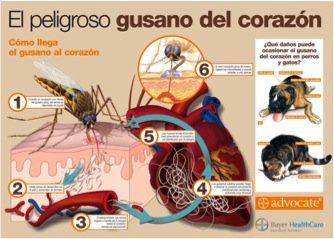What is filariasis?
The heartworm (also known as filariasis or heart worm disease) is one parasitic disease of wide distribution in Spain and that mainly affects the canids and more specifically our dog.
The disease is caused by adult worms of the family of the Nematodes and gender Dirofilaria.
Is transmitted by mosquito bite and it consists of the presence of worms that lodge in the heart and lungs of the dog, being able to get to cause heart failure and death.
How is filariasis transmitted?
The mosquito transmits the parasite (called filaria or heart worm) of one sick dog to another healthy. The adult of filaria released larvae in an infected dog (microfilariae) straight into your bloodstream.
Mosquito ingests these microfilariae alongside blood and inside they develop into infective forms, It will stay in your oral cavity until it returns to feed.
The mosquito transmits the parasite larvae When bites a healthy animal. They begin their journey to your location
definitive where they will reach the adult form and begin to reproduce thus beginning a new life cycle.

Is my dog at risk?
Filariasis is endemic in much of Spain (Mediterranean coast from Malaga to Tarragona, the Ebro Valley, Valley of the Tormes, Balearic Islands, Canary Islands and coast of Huelva and Cadiz)
The 76.9% owners of dogs they do not know who live in risk of filaria zone
–How can I know if my dog is infected??
Take your dog to the veterinarian on a regular basis to subject you to tests of filariasis
The initial phase of the disease can present without symptoms, Therefore it is very important to visit regular veterinarian to check the status of your pet's health.
A simple analysis done in fresco under the microscope allows you to check for the presence of microfilariae in the blood. But, It is advisable to carry out a serological test to confirm the presence or absence of adult forms.
main symptoms:
Most dogs with heartworm infection they do not show signs of disease. Some dogs they may show decreased appetite, weight loss and apathy. Often, the first sign of the disease is cough. Animals with serious heart worm disease will begin to showlack of resistance during exercise. Some accumulate fluid in the abdomen (ascites) that makes them seem bellied. In rare situations in which animals have many adult worms, these can die from sudden heart failure.
But, in case of low concentration of parasites and in the initial stage, diseaseIt may occur in asymptomatic. Thus, It is very important to regularly go to the vet to make the test of control.
What happens if my dog gets infected?
Infestation by Dirofilaria inmitis is very dangerous and, If it is not prevented in time, You can have fatal consequences.
The adult parasites can reach a considerable size (more than 30 cm length) to such an extent that they prevent normal development of cardiac functions and, at the same time, are toxic to the liver and kidneys.
When the disease is found at a more advanced stage, the most obvious symptoms are tiredness, cough and weight loss (symptoms that are aggravated by exercise).
For dogs that are negative to the test serological two types of preventive treatments, the oral (monthly) and the injectable (annual).
Treatment
If the diagnosis of the presence of adult heartworm (heart worms), the dog must be subjected to a treatment as soon as possible, supplying a drug finish with the parasite and renders unable them to reproduce.
As an alternative, You can resort to a very delicate surgical operation that serves to eliminate the parasites directly from the heart of the sick dog.
In summary…
Filariasis is a disease present in our environment and which is very easy to prevent contagion in our dog.
Go to your veterinarian and ask for the program of prevention of the Filaria or cutworm is carried out. With a single annual prick you can forget this annoying problem.
Source: VANESSA RODRÍGUEZ GONZÁLEZ
Via: oyccanarias




